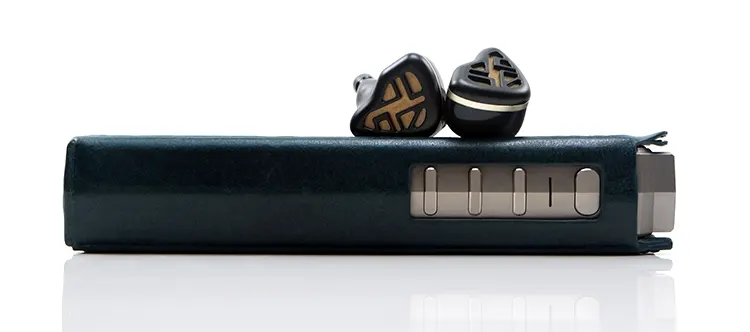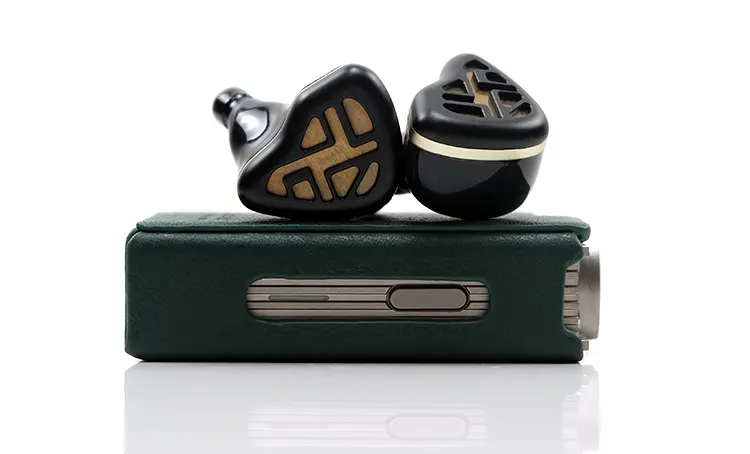Sound Impressions
The following sound impressions of the Rossi&Wing First Light were completed using a mix of the iBasso DX320 MAX Ti, HiBy’s RS8, and the ONIX Mystic XP1 with the stock wide-bore silicone tips.
Summary
The First Light delivers a dense and powerful sound signature taking its cue from its low-end R-ESTDD and doubling down with a rounded analog-like tone from its BA-powered mids, topped with a relatively relaxed set of highs.
Arguably a warm to slightly dark tonal profile, the First Light’s timbre is even-harmonic biased with a strong fundamental and subtle contrast, particularly through the upper mids and lower treble.
This makes First Light an easy yet enjoyable listening experience, one in which the rhythm sections carry some convincing weight and texture.
This is a cracking performer for classic rock artists such as Deep Purple or modern ‘chuggers’ such as Metallica. Anything with a deep bass line sounds authoritative on the First Light.
I got a similar pleasing experience with guttural male vocals, for example, James Hetfield on Metallica’s latest 72 Seasons recording sounded thunderous with the First Light. Quite often dipped lower-mids can suck the life out of James’s vocal power, but not here.
The flip side is the lack of air for upper-register vocals with percussion presence and bite a shade muted sounding.
Lovers of the PMG Audio Apx or 64 Audio’s Fourte might struggle with the reduced upper harmonic overtones necessary for tonal contrast and shining a spotlight on subtle spatial cues and micro-detail. Vision Ears Phonix fans will be more welcoming of the First Light tuning.
The First Light is not a particularly difficult monitor to drive well. You can get a decent performance from a dongle or a DAP pairing.
I recommend pairing it with either a clean and resolving source with good treble presence such as the iBasso DX320 MAX Ti or a DAP that excels in bass punch and control such as the HiBy RS8 or the ONIX Mystic XP1.
Frequency Response
The star is the 10mm R-ESTDD so it is no surprise to see the First Light FR with an elevated but fairly linear bass shelf from 20Hz right up to 100Hz with a slow drop into the lower-mids around 500Hz.
The drop isn’t huge either, there is no deliberate suck-out to prevent bass bleed which helps keep most lower-register instruments pleasingly to the fore but in turn, this allows for a bit of warmth to seep upwards into the lower-mid timbre.
There is some pinna gain from 1-4k, but it’s largely in line with the bass shelf, so there are times when both compete for the same staging space.
A quick 3-4 dB peaking filter boost from a PEQ app at around 4-5k with a Q factor of 0.7 or 0.3 in the First Light response curve can make a big difference, improving separation and adding some contrast in the vocal timbre.
Bear in mind that FR tweak is a personal preference for full ensemble recordings. I would not mess with the First Light FR if I am listening to breathy vocal acapella recordings, which it seems particularly suited to.
From 5k onwards the First Light starts to naturally attenuate with a secondary mild bump around 8k that is subtle but audible before bottoming out beyond 10k. Treble is there but it’s not a front-and-center type of listening experience.
Coloration
Subjectively, the First Light delivers some gorgeous note textures, especially from its powerful, physical, yet surprisingly articulate R-ESTDD driver.
The First Light harmonic balance is decidedly even-harmonic with more influence from the 2nd order down to the fundamental overtones and less contrast from the upper order.
Bass twangs are rich and weighty and vocals are full-blooded with plenty of sustain and warmth. This is not a lush or sweet-sounding signature. It doesn’t carry that same sparkle with more of a rounded tonal quality at times.
It reminds me a little of some of my analog-dominant source sound signatures such as the Cayin RU7 or an R-2R DAC such as the Ladder Schumann.
Percussion timbre has a stronger focus on body and texture from the preceding strike rather than the splash and fizzle-out for want of a better phrase.
You will not find any noticeable harmonic dissonance from the First Light’s upper-register instrumental performances meaning a smooth and easy listening experience.
Air can be a premium at times. Those who are used to the cleaner tones of competing monitors might find the upper-mids of the First Light lacking in edge and bite.
You can PEQ this up a bit and it will improve vocal bloom but exercise caution to prevent it from becoming shouty in the process.
Staging & Dynamics
The First Light projects excellent staging depth good width and reasonable highs though not as forceful and open in the mids as some of the flagship competition.
Lower mids instrumental presence and hard rock lower-register vocals sound excellent with the First Light. Female vocals can also hit home beautifully on recordings with sparse mixes.
Not so much that they cut through with searing accuracy or chiseled definition. Rather, they generate excellent power with an emotive presence where other IEMs sound lean and diffuse.
The upper-mids through to the highs are on the darker side. It doesn’t lack headroom, and the staging dimensions are generous but rather there is a dip in the upper mids which sucks a bit of air out and condenses the presentation in the process.
The secondary 8k bump is thoughtful, but a little more dB around 4-6k from any PEQ software to enhance vocals separation and impact improves the First Light’s highs immeasurably, creating a much more dynamic high-end sound signature.
Synergy
Efficiency & Sensitivity
The Rossi&Wing First Light is rated at 13.5Ω @ 1 kHz for impedance with an SPL of 113 dB/mW @1kHz making it relatively easy to drive from dongles and DAPs.
Compared to competing flagship IEMs such as the planar-infused hybrid PMG Audio Apx and the quad-driver 64 Audio Fourte, it is slightly easier to drive though not as sensitive as our third compared IEM, the all-BA Vision Ears Phonix.
Also, it’s not sensitive enough to pick up any background hiss from higher than normal noise floors including high gain stage settings such as Stage 5 from the iBasso DX320 MAX Ti.
The First Light also showed no noticeable impedance skew in its performance with the ONIX Mystic XP1, a portable amp/DAC with a balanced output rated at 6.6Ω which I consider quite high.
DAP Pairings
I tested 5 DAPs and the Onix Mystic XP1 which has local file playback capability with my preferences with the First Light pairing evenly splitting them into two groups of 3.
Those preferences centered on clarity, vocal presence, and bass dynamics, often my three touch points for how I like to enjoy my IEMs.
DAP Group 1
The first group hit all 3 with the DX320 MAX Ti producing the cleanest mids and highs from the First Light. It also projects the tallest and widest soundstage and of the 6 was the most resolving.
The HiBy RS8, however, was perhaps my favored pairing out of the six with superb bass dynamics using the Turbo mode in a low gain setting. Its vocal presence is not quite as strong as the DX320 MAX Ti but it extends well and provides decent headroom to ensure the vocal performances are not swallowed up by that killer bass line.
The surprise inclusion was the Mystic XP1. I was expecting this to be quite muddy given how dense the XP1 sounds by default. However, the bass, though powerful, was quite well controlled with plenty of space and no discernable muddiness.
Vocals from the First Light were more forward-sounding than the aforementioned DAPs and sounded rich and weighty. The only drawback was a comparative lack of treble extension giving the First Light a darker tonal complexion.
DAP Group 2
The second group of DAPs introduced a softer, more muted quality to the First Light. Not so much that they were warmer, in the case of the HiBy R8 II, it was not.
Rather, the dynamics felt flatter compared to the first 3 sources and for me, the First Light needs a bit of contrast and excellent dynamics to sound just right.
It was a similar case with the Cayin N8ii and the N7. The N8ii needs to be set to the solid-state setting to get a shorter decay and more punch to enhance the perceived clarity from the First Light. The tube timbre sounded slightly soft and too polite to control the First Light’s bass dynamics.
The N7 isn’t exuberant enough through the mids meaning vocals lack prominence. The First Light is relatively relaxed through the mids on the N7 so, while I enjoyed its wide staging presentation the clarity and midrange presence weren’t as convincing as the higher-end DAPs.
Dongle Pairings
With the same 3 focus points in mind, namely clarity, vocal presence, and bass dynamics, I tried the iBasso DC-Elite, Cayin’s RU7, and the HiBy FC6.
The DC-Elite was the clear winner if you want all 3 key points together in one package. The First Light pairing sounded impactful and clear in the lows with excellent depth, relatively open in the mids, and better than average vocal presence.
The FC6 came in a close second but purely because it had a fairly emotive sound with the First Light, being the weakest of the three dongles for staging width and note separation. I enjoyed this one for how much bass and vocal presence it was able to dig out from the First Light. A very colored but enjoyable pairing.
The Cayin RU7 sort of drifted in between those two, sounding as wide as the DC-Elite but not as prominent in vocal presence or bass weight.
It is a refined, analog sound with the First Light but my preferences demanded something with either a bit more bite in the mids or more slam on the lows. This pairing sounded too rounded and polite.






